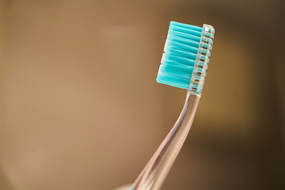|
more active arms. You want big motions, big power, to come from bigger joints and bigger muscles. Fingers are really good at the small things: articulating. The arm, specifically the elbow joint, is really good at creating the motion needed for a big sound at the piano. The common wisdom says that you play the piano with your fingers. I try to emphasize with beginning students that the fingers are more than anything just a conduit for bigger muscles to transfer motion to the keys. Tiny muscles that they have, we want our fingers to have to work only as a last resort.
Obviously, this is complex language. When teaching beginning piano students, you don't want to overburden them with technical language. In fact, you don't want them to really know that they're learning at all. A fundamental principle in piano pedagogy is that you relate new knowledge to old knowledge. What kids do understand naturally, by the time they're beginning piano lessons, is brushing their teeth. And unless they use an electric toothbrush, they understand that bristles on an old-fashioned toothbrush don't do any work themselves. But they're essential to brushing! Kids immediately and intuitively understand that it's our arm that's the source of motion when brushing their teeth. So, I give them a toothbrush to play on the piano. It just so happens that the 'arm' of the toothbrush corresponds nicely to our forearm, the 'joint' of our hand holding the toothbrush corresponds to the elbow. The bristles of a toothbrush even look like our fingers hanging from our hand in a beautiful piano hand position. I'll have my students play quite a bit with the toothbrush, then ask them to treat their fingers just like the bristles. Generally, they intuitively make the connection, they can play with quite a big sound, without pushing or forcing. Their fingers are more passive and their arm more active, and they have nice alignment as well as hand position. Throughout their early years, I can continue to refer to "toothbrush arm" as a technical tool for specific pieces. This way I also never have to talk about their wrists. They innately understand that the "wrist" of a toothbrush isn't floppy, but it isn't a cement block either. Again, it's a conduit, a tube where motion from the arm travels to the fingers. They get that all the wrist has to do is just not get in the way. |
"Modern performers seem to regard their performances as texts rather than acts, and to prepare for them with the same goal as present-day textual editors: to clear away accretions. Not that this is not a laudable and necessary step; but what is an ultimate step for an editor should be only a first step for a performer, as the very temporal relationship between the functions of editing and performing already suggests." -Richard Taruskin, Text and Act Archives
March 2021
Categories
All
|

 RSS Feed
RSS Feed
